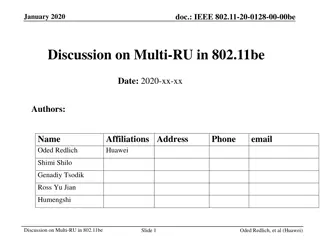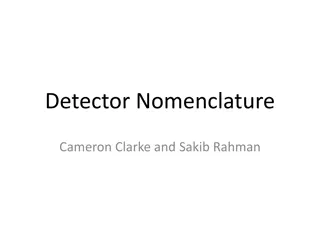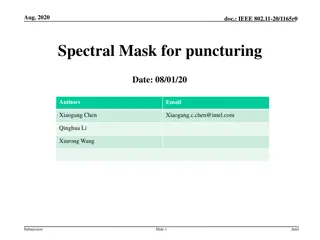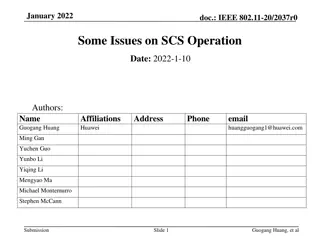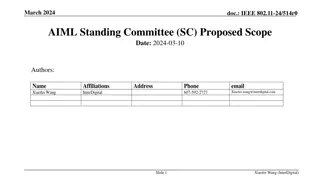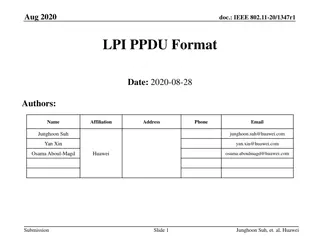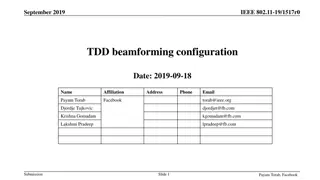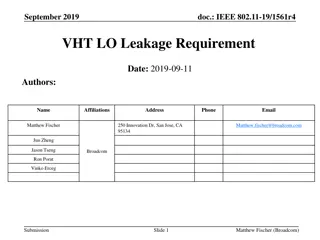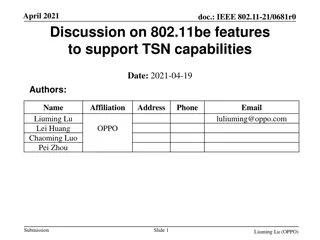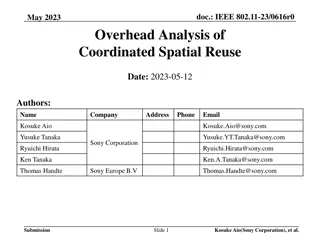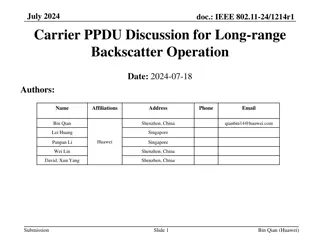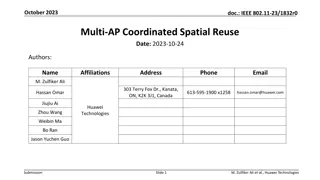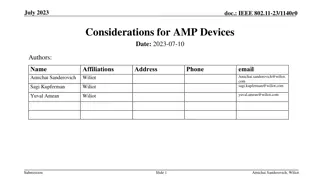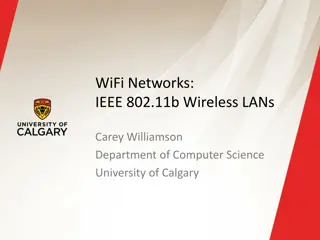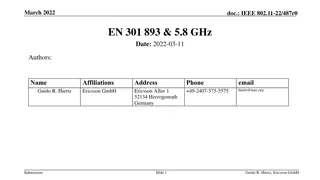Discussion on Proposed Nomenclature for IEEE 802.11ba Standard
This document presents a discussion on the proposed nomenclature for the IEEE 802.11ba standard draft amendment, highlighting the need for clarity and consistency in terminology to avoid confusion and specification issues. Various new terms and definitions are suggested for different types of devices involved in the standard. The author, Joseph Levy from InterDigital, provides insights on refining the terminology to enhance understanding and agreement within the technical group.
Download Presentation

Please find below an Image/Link to download the presentation.
The content on the website is provided AS IS for your information and personal use only. It may not be sold, licensed, or shared on other websites without obtaining consent from the author. Download presentation by click this link. If you encounter any issues during the download, it is possible that the publisher has removed the file from their server.
E N D
Presentation Transcript
September 2018 doc.: IEEE 802.11-18/1641r0 Discussion on WUR (802.11ba) Nomenclature Date: 2018-09-12 Authors: Name Affiliations Address 2 Huntington Quadrangle 4th floor, South Wing Melville, NY 11747 Phone email jslevy@ieee.org Joseph LEVY InterDigital, Inc. +1.631.622.4139 Submission Slide 1 Joseph LEVY (InterDigital)
September 2018 doc.: IEEE 802.11-18/1641r0 Abstract This contribution provide a discussion on the nomenclature currently used in the TGba draft amendment (IEEE P802.11ba/D0.4). The intent of this document is to kick off discussion in the ARC SC and comment from the TGba so that agreement can be reached on the nomenclature. Submission Slide 2 Joseph LEVY (InterDigital)
September 2018 doc.: IEEE 802.11-18/1641r0 Why Propose new Nomenclature 1. The current nomenclature used by TGba does not follow current 802.11 norms and may cause confusion and create specification problems. 2. Redefining a non-AP STA to be a PCR and a WURx is a new definition of an existing term. The meaning of a non-AP STA is clear and well understood and should not be redefined. 3. There is no need to introduce the concept of a PCR (primary connectivity radio) as this radio is a STA, or more precisely a non-AP STA. 4. There are potentially multiple types of devices that can transmit WUR frames or can negotiate WUR setup, currently only a WUR AP is defined as a device that can transmit WUR frames and communicate with a WUR non-AP STA to establish WUR PM. Does the amendment want to be so restrictive? Submission Slide 3 Joseph LEVY (InterDigital)
September 2018 doc.: IEEE 802.11-18/1641r0 Proposed Nomenclature for the STA The WUR non-AP STA is currently used in the draft amendment, A WUR non-AP STA includes a PCR component and a WURx, which has the capability to receive WUR PPDU. [1], to describe a device containing a STA and a WURx. This is confusing hence it is proposed use the following: exclusively: 1. WUR device - comprising one or more non-AP STA(s) and a WURx (assuming that that there is only one WURx per device) 2. non-AP STA (currently the PCR in the draft) this term should not change its definition or what it refers to in the current specification. 3. WURx As it is currently defined in the draft (see following slides) Submission Slide 4 Joseph LEVY (InterDigital)
September 2018 doc.: IEEE 802.11-18/1641r0 Proposed Nomenclature AP 1. WUR AP an AP that is capable of negotiating a WUR configuration with a WUR device via the device s non-AP STA. 2. WUR Capable AP which is a WRU AP that is also capable of transmitting WUR frames to the WURx. 3. WUR Transmitter a device capable of transmitting WUR frames this device must be capable of being controlled by a WUR AP, WUR Capable AP, or some WUR entity in the ESS that is aware of the WUR configuration/capabilities of the WUR device and when that device should be/can be woken up. Submission Slide 5 Joseph LEVY (InterDigital)
September 2018 doc.: IEEE 802.11-18/1641r0 EXISTING DEFINITIONS OF INTEREST Submission Slide 6 Joseph LEVY (InterDigital)
September 2018 doc.: IEEE 802.11-18/1641r0 Current TGba Definitions [1] 1/2 primary connectivity radio (PCR): A radio with the capability to transmit and receive 20 MHz non-HT PPDU. wake-up radio (WUR): A companion radio to a primary connectivity radio with the capability to transmit or receive WUR PPDU. wake-up radio (WUR) channel: A channel in which a WUR non-AP STA in WURx awake state listens. wake-up radio (WUR) discovery channel: A channel in which the WUR discovery frames are transmitted wake-up radio (WUR) primary channel: The common channel of operation for all WUR stations (STAs) in which the WUR beacons are transmitted. wake-up radio (WUR) primary 40 MHz channel: The 40 MHz channel that is used to transmit 40 MHz WUR Frequency Division Multiple Access (FDMA) physical layer (PHY) protocol data units (PPDUs). Submission Slide 7 Joseph LEVY (InterDigital)
September 2018 doc.: IEEE 802.11-18/1641r0 Current TGba Definitions [1] 2/2 wake-up radio (WUR) primary 80 MHz channel: The 80 MHz channel that is used to transmit 80 MHz WUR Frequency Division Multiple Access (FDMA) physical layer (PHY) protocol data units (PPDUs). wake-up radio (WUR) secondary channel: The 20 MHz channel adjacent to the WUR primary channel that together form the 40 MHz channel. wake-up radio (WUR) secondary 40 MHz channel: The 40 MHz channel adjacent to the WUR primary 40 MHz channel that together form the 80 MHz channel. wake-up radio (WUR) physical layer (PHY) protocol data unit (PPDU): A PPDU transmitted with the TXVECTOR parameter FORMAT equal to WUR. wake-up receiver (WURx): A companion receiver to a primary connectivity radio with the capability to receive WUR PPDU. Submission Slide 8 Joseph LEVY (InterDigital)
September 2018 doc.: IEEE 802.11-18/1641r0 Current TGmd Definitions [2] 1/3 access point (AP): An entity that contains one station (STA) and provides access to the distribution system services(Ed), via the wireless medium (WM) for associated STAs. An AP comprises a STA and a distribution system access function (DSAF). service set transition: A station (STA) movement from one basic service set (BSS) to another BSS, i.e., either a BSS transition or an extended service set (ESS) transition. serving access point (AP): The AP to which the station (STA) is associated. station (STA): A logical entity that is a singly addressable instance of a medium access control (MAC) and physical layer (PHY) interface to the wireless medium (WM). NOTE For IEEE 802.11 purposes, a station is any MAC/PHY entity providing the IEEE 802.11 MAC services. This differs from the IEEE 802 definition of station, which includes bridges (or end stations ) that are endpoints of link layer data traffic. station service (SS): The set of services that support transport of medium access control (MAC) service data units (MSDUs) between stations (STAs) within a basic service set (BSS). Slide 9 Submission Joseph LEVY (InterDigital)
September 2018 doc.: IEEE 802.11-18/1641r0 Current TGmd Definitions [2] 2/3 deep sleep mode: A mesh power management mode with respect to a neighbor peer mesh STA in which a mesh station (STA) alternates between awake and doze states and is not expected to receive beacons from this neighbor peer mesh STA. high-throughput (HT) station (STA) 2G4: An HT STA that is also a STA 2G4. high-throughput (HT) station (STA) 5G: An HT STA that is also a STA 5G. IEEE 802.11 station (STA): Any station that is compliant with IEEE Std 802.11. Any reference to the term station (STA) in this standard that is not qualified by the term IEEE 802.11 implicitly refers to an IEEE 802.11 station. power save (PS) mode: A power management mode in which a nonmesh station (STA) alternates between awake and doze states. power save (PS) station (STA): A station that is in power save mode. Submission Slide 10 Joseph LEVY (InterDigital)
September 2018 doc.: IEEE 802.11-18/1641r0 Current TGmd Definitions [2] 3/3 station (STA) 2G4: A STA that is operating on a channel that belongs to any operating class that has a value of 25 or 40 for the entry in the Channel spacing column and that has a value of 2.407 or 2.414 for the entry in the Channel starting frequency column of any of the tables found in E.1 (Country information and operating classes). station (STA) 5G: A STA that is operating on a channel that belongs to any operating class that has a value of 20 or 40 for the entry in the Channel spacing column and that has a value of 5 for the entry in the Channel starting frequency column of any of the tables found in E.1 (Country information and operating classes). Submission Slide 11 Joseph LEVY (InterDigital)
September 2018 doc.: IEEE 802.11-18/1641r0 Current TGmd Definitions, recently added [2] (11ah)target wake time (TWT): A specific time or set of times for individual stations (STAs) to wake in order to exchange frames with other STAs. (11ah)target wake time (TWT) responder: A station (STA) that has accepted a TWT agreement that was requested by another STA and that assigns TWT service period (SP) start times to the requesting STA. (11ah)target wake time (TWT) service period (SP): A period of time during which a TWT station (STA) is awake to transmit and/or receive frames. (11ah)target wake time (TWT) service period (SP) start time: The value of the timing synchronization function (TSF) at the beginning of a TWT SP. (11ah)target wake time (TWT) requester: A station (STA) that has had a requested TWT agreement accepted by another STA and that receives TWT service period (SP) start times from that STA. Submission Slide 12 Joseph LEVY (InterDigital)
September 2018 doc.: IEEE 802.11-18/1641r0 References 1. IEEE P802.11ba /D0.4; Draft STANDARD for Information Technology; Telecommunications and information exchange between systems; Local and metropolitan area networks; Specific requirements; Part 11: Wireless LAN Medium Access Control (MAC) and Physical Layer (PHY) specifications; Amendment 9: Wake-Up Radio Operation; August 2018 2. IEEE P802.11REVmd_D1.5.pdf; Draft Standard for Information technology; Telecommunications and information exchange between systems; Local and metropolitan area networks; Specific requirements; Part 11: Wireless LAN Medium Access Control (MAC) and Physical Layer (PHY) Specifications; September 2018 Submission Slide 13 Joseph LEVY (InterDigital)
















